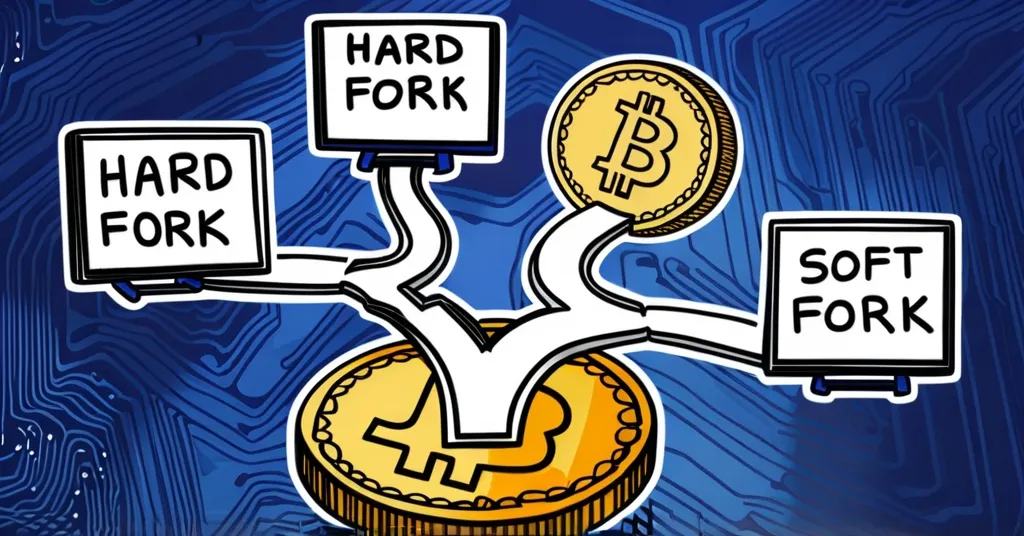Hard Fork vs. Soft Fork: Decoding Blockchain’s Evolutionary Path

Hard Fork vs. Soft Fork: Understanding Blockchain Evolution
Understanding hard forks and soft forks is crucial for anyone invested in the future of blockchain, as they represent the pivotal moments that shape the technology’s evolution. These mechanisms can either drive innovation or lead to significant community splits, impacting the entire cryptocurrency landscape.
- Hard Fork: A significant protocol change
- Soft Fork: Backward-compatible update
- Bitcoin Cash (BCH): Created from a Bitcoin hard fork
- SegWit: An example of a Bitcoin soft fork
What is a Hard Fork?
A hard fork is like a restaurant splitting into two new branches with entirely different menus. It represents a significant change to the blockchain protocol that requires all nodes on the network to upgrade to the new version. If not everyone agrees to the change, it can result in a permanent split into two separate blockchains. A node, in blockchain terms, is a computer connected to the network and validating transactions.
A prime example is the creation of Bitcoin Cash (BCH) in 2017, a notable hard fork of Bitcoin. BCH was launched with the goal of addressing scalability issues by increasing the block size from 1MB to 8MB, and later to 32MB, aiming to accelerate transaction speeds. This move was driven by the belief that larger blocks would help Bitcoin scale more effectively, though it led to further forks like Bitcoin SV (BSV), reflecting ongoing debates within the community.
What is a Soft Fork?
On the flip side, a soft fork is more like a restaurant updating its menu but keeping the same overall theme. These updates are backward-compatible, meaning nodes that haven’t upgraded can still interact with the network. An iconic example is Bitcoin’s SegWit update in 2017, designed to address the ability to alter transaction data before it’s confirmed (transaction malleability) and enhance scalability. Unlike hard forks, soft forks maintain a single blockchain, ensuring a smoother transition.
Reasons for Forks
- Planned upgrades to improve the system
- Community disagreements over the direction of the project
- Efforts to reverse undesirable events, like hacks
- Creation of new cryptocurrencies
Forks aren’t just technical maneuvers; they’re reflections of the community’s vision and priorities. While they can introduce enhancements and attract new interest and investment, they carry risks like community splits and potential project collapse if not managed with care and consensus.
Real-World Examples and Case Studies
Beyond Bitcoin Cash, other significant hard forks include Bitcoin SV (BSV), which emerged from BCH due to disagreements over block size, and Bitcoin Gold (BTG), created to make mining more accessible by using GPUs instead of ASICs. The latter’s post-mine strategy, where 100,000 coins were mined post-fork to fund development, sparked controversy within the community.
Ethereum Classic (ETC) provides another compelling case study. It resulted from a hard fork of Ethereum after the DAO hack in 2016, where the community split over whether to reverse the hack’s effects. ETC maintained the original chain, emphasizing the principle of “code is law,” while the new Ethereum chain reversed the hack.
Benefits and Challenges
The benefits of forks include resolving project issues and attracting new attention and investment. They allow for innovation and adaptation, ensuring that the technology can evolve to meet the needs of its users and the broader ecosystem. However, navigating these changes requires a delicate balance of technical prowess and community consensus.
The challenges are significant. Forks can lead to community splits, as seen with BCH and BSV, and even result in project collapse if not executed properly. Bitcoin maximalists often view these forks as distractions from Bitcoin’s original vision, yet they acknowledge that altcoins and other blockchains fill niches that Bitcoin might not serve well. This tension reflects the broader debate about the future of decentralized finance.
The Future of Forks in Blockchain
As blockchain technology continues to evolve, forks will remain a tool for both evolution and disruption. The concept of effective accelerationism (e/acc) highlights how forks contribute to the rapid evolution and disruption of traditional finance, aligning with the broader mission of decentralization and innovation.
Looking ahead, we can expect more forks, each with the potential to either enhance or challenge the existing landscape. The key will be to balance innovation with the need for consensus, ensuring that the crypto community remains united in its mission to revolutionize finance.
Key Questions and Takeaways
- What is the difference between a hard fork and a soft fork in blockchain?
A hard fork is a significant change to the blockchain protocol that can result in a permanent split into two separate blockchains, whereas a soft fork is a backward-compatible change that maintains a single blockchain.
- Why do hard forks and soft forks occur in blockchain?
Forks can occur due to planned upgrades, community disagreements, efforts to reverse undesirable events, or to create new cryptocurrencies.
- Can you provide an example of a hard fork?
The creation of Bitcoin Cash (BCH) from Bitcoin is an example of a hard fork, aimed at increasing the block size to address scalability issues.
- What is an example of a soft fork?
Bitcoin’s SegWit update in 2017 is an example of a soft fork, designed to address transaction malleability and enhance scalability.
- What are the benefits and challenges of implementing forks in blockchain?
Benefits include resolving project issues and attracting new attention and investment. Challenges include the risk of community splits and potential project collapse if not managed well.
A hard fork in blockchain is like starting a new chapter in a book where the plot completely changes, and you can’t go back to the old story.
On the other hand, a soft fork in blockchain is more like editing a chapter to improve it without changing the overall story.
As we continue to witness the evolution of blockchain, understanding the nuances of hard and soft forks becomes crucial. They are not just technical terms; they represent the ongoing journey of a technology that is redefining the future of finance and beyond. And let’s not forget, in the world of crypto, change is the only constant – and forks are just the beginning of the story.



